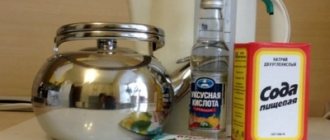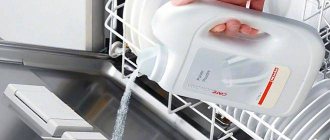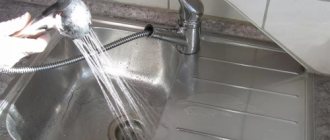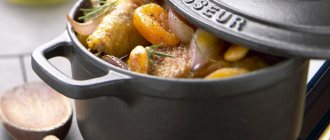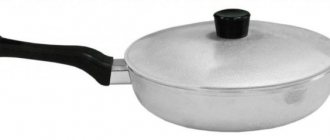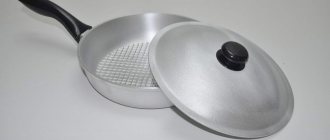Many housewives prefer stainless steel pans. This material has proven itself to be one of the most durable. In addition, it is considered environmentally friendly, which means it is completely safe for health and cooking. Even after several decades, the dishes will remain shiny and clean if you care for them properly.
We will tell you a few secrets on how to clean stainless steel. You need to know them in order to successfully deal with burnt marks and dirt. And photos and videos will help you avoid making mistakes when choosing products to care for kitchen utensils, after using which they will shine.
Features of the material
Stainless steel cookware is a success for a reason - the advantages of steel products have been tested for more than one generation. Housewives value shiny kitchen utensils for their lightness, durability, and ease of cleaning. The main six advantages of cookware are considered.
- Corrosion resistance. Stainless steel contains chromium. It is this element, when reacting with oxygen, that creates a protective anti-corrosion film on the surface of the material, which has the ability to self-renew.
- Strength and durability. Stainless steel is resistant to mechanical deformation: chips, scratches. With proper care, products made from this material can last for decades.
- Heat resistance. Utensils made of steel do not lose their functional characteristics over a wide range of temperatures: kitchen appliances made of stainless steel can be used at both low and high temperatures.
- Environmental friendliness. The high density of the material does not allow pathogenic microorganisms to accumulate on the walls of the dishes. Scientific research has confirmed the bacteriostatic properties of stainless steel.
- Versatility. Steel cookware can be used for cooking food on gas, glass-ceramic and induction cookers.
- Impeccable appearance. The metallic shine of steel utensils will fit into any interior: such utensils look stylish and presentable if you properly care for them.
Stainless steel cookware does not affect the taste of food during cooking or during long-term storage in it.
Possible damage and contamination
Kitchen utensils made of steel retain their advantages only with proper care. If the surface of the product is damaged, dirt and grease accumulate on the walls of the kitchen utensil. This leads to the following problems:
- anti-corrosion properties are lost;
- wear resistance decreases;
- food begins to burn during heat treatment;
- the appearance becomes dull and unsightly.
Improper use can lead to three “diseases” of steel cookware.
- Nagar. Immediately uncleaned, the yellow coating formed by splashes of fat gradually becomes a hard, dark-colored “shell.”
- "Rainbow" on the bottom and walls. The film lining the product thickens when heated to 100 °C. When the layer's density increases tenfold, it turns blue or rainbow. This affects not only the appearance of the product, but also its functionality.
- Scale. Limescale is a deposit of calcium carbonate in water. The metal reacts with impurities contained in tap water: dotted spots appear on the inner surface of the product. When boiling, chlorine and mineral salts settle on the bottom and walls, forming spiral-shaped “patterns”.
To extend the life of kitchen utensils and maintain their appearance, it is worth providing stainless steel utensils with proper care.
Secrets of care
Stainless steel cookware needs to be maintained regularly. Three simple rules will help preserve the functionality and decent appearance of the dishes for a long time, and will not allow severe contamination.
- Regular cleansing. After each use, the product must be washed with a soft sponge and detergent with a gentle formula. This measure will prevent the appearance of stains and eliminate the need to scrape off pieces of dried food.
- Delicate wash. It is recommended to wash stainless steel utensils by hand; you should not use a dishwasher.
- Perfect dryness. If you leave a stainless steel appliance to dry naturally in the open air, the dishes may become covered with dark spots. Therefore, each time after washing, the product must be wiped dry with a clean towel.
When cooking, you can only use filtered water and do not heat an empty pot or frying pan for a long time. If you cannot avoid contaminants that a regular detergent cannot deal with, you need to resort to stronger methods.
Principles of cleansing
Cleaning steel utensils is based on four principles.
- We say a firm “no” to harsh methods. Do not use products containing abrasives; the use of metal sponges and brushes is also unacceptable.
- We choose products without ammonia and chlorine. These components may damage the surface of products.
- We use salt and soda only in warm and hot water. Adding large amounts of these products to cold water can cause dark spots to appear on stainless steel cutlery.
- Don't put off cleansing. “Fresh” contamination is much easier to remove.
You can fight pollution using store-bought or folk remedies.
What to choose in the store
When you go shopping for a stainless steel dish cleaner, you need to:
- analyze reviews - recommendations will help you make the right choice;
- study the composition - the product should not contain abrasives, chlorine and ammonia;
- pay attention to the markings - the manufacturer must indicate for which materials a particular product is suitable.
It is advisable to give preference to proven means. Judging by the reviews, they have proven themselves well:
- "Dafor";
- "The Shine of Steel";
- "Selena";
- "Shumanite";
- Luxus;
- Help;
- Delu;
- Dr. Beckmann;
- Fresh.
Some housewives use oven cleaners to clean stainless steel cookware from grease and other contaminants. They apply the gel for 15-20 minutes, then wash the product with regular detergent.
How not to wash a stainless steel pan
Not all products are suitable for stainless steel. You need to know which of them are prohibited to use so as not to damage the dishes.
- It is not recommended to clean pots with products containing chlorine.
- Do not choose hard brushes for surfaces as they can damage the material. Give preference to silicone dish sponges, which are usually used for cleaning enamel.
Now you know exactly how to clean a burnt stainless steel pan. Follow our simple tips to keep your kitchen tidy. As you can see, it's not difficult, you just need to know some secrets. Let cleaning your apartment always be easy, we wish you good luck!
How to wash stainless steel dishes using your grandmother's experience
You can clean stainless steel cookware from dark stains, carbon deposits and other contaminants using improvised means that will ensure the most delicate effect.
Universal solution: boiling
Boiling is the most effective way to clean stainless steel kitchen utensils. This method will successfully handle:
- soot;
- scale;
- greasy yellow coating;
- other complex contaminants.
If you need to clean the inside of a pot or pan, three simple steps will help.
- Prepare the composition. Fill the contaminated dishes with a special solution.
- Put on fire. Wait for it to boil, boil for 15 minutes.
- Remove from heat, cool. Wash the product with detergent.
If you need to clean spoons, forks, as well as frying pans, pots, bowls and teapots not only from the inside, but also from the outside, follow the three-step instructions.
- Preparation. Pour the solution into a large heat-resistant container (you can use a bucket).
- Boiling. Immerse the dishes in the mixture and boil for five to 15 minutes.
- Rinse. Remove from heat, cool, and wash items with detergent.
How to prepare the composition for boiling? If the contamination is not severe, you can boil the dishes in clean water. To enhance efficiency, it is worth making a solution (of your choice):
- dishwashing detergent - two to four tablespoons per liter of water;
- vinegar - combine with water in a 1:1 ratio;
- laundry soap and PVA glue - dissolve a third of a bar of soap and a tablespoon of glue in 4 liters of water;
- soda ash, household soap and silicate glue - 100 ml of glue and soda each, a bar of soap per 10 liters of water.
Instead of dishwashing detergent, you can use liquid or crushed laundry soap in the same proportions.
It will cope well with light stains and remove “boiling apple” blackness. You need to peel the sour apples, add water, and boil stainless steel products in this solution for five to seven minutes. Instead of fruit peels, you can use potato peelings or finely chopped onions.
Anti-carbon pastes
Peculiarities. You can remove carbon deposits from a stainless steel pot or frying pan using homemade pastes.
Components to choose from:
- crushed activated carbon (30-40 tablets), mixed with water to a paste consistency;
- ground coffee beans mixed with water to form a thick paste.
Application
- Apply the composition in a thick layer to the contaminated areas.
- Wait 20-30 minutes.
- Wash the device with regular detergent.
Liquids from white deposits and scale
Peculiarities. You can remove scale from a stainless steel kettle using simple products. The concentration of citric acid is adjusted depending on the degree of contamination: from 15 to 50 g per liter of water. Turks and samovars made of stainless steel can be washed in a similar way.
Components to choose from:
- vinegar;
- citric acid solution;
- Coca Cola.
Application
- Pour the product into the “affected” product.
- Bring to a boil and simmer over low heat for a couple of minutes.
- Drain the mixture and add clean water.
- Boil and wash with regular detergent.
Methods for processing forks and knives
Four products will help clean stainless steel cutlery from black deposits and other contaminants.
- Vinegar or lemon juice. Apply the product to a soft cloth and wipe the devices. After half an hour, rinse with running water and wipe dry.
- Ammonia. High concentrations of ammonia are harmful to stainless steel products. However, if you mix five to ten drops in a liter of water, you can get a solution that will perfectly clean cutlery. It is enough to rub the products with it and then wash with regular detergent.
- Non-abrasive toothpaste or tooth powder. Using a soft cloth, wipe the devices and wash with running water.
- Mustard powder. Dilute the product with a small amount of warm water to obtain a creamy mass. Immerse cutlery in the composition for a quarter of an hour, then rinse with running water.
Care instructions
When caring for stainless cookware, it is recommended:
Wash or soak items immediately after preparing food.- Do not pour cold water into hot pots and pans.
- Avoid overheating empty dishes.
- When cooking food, salt not cold water, but boiling water.
- To dissolve the fat, pour a little dish soap into the soaking solution.
- When using natural products (for example, laundry soap, mustard), soften hard water with a small amount of soda.
- After washing, wipe the dishes with paper or cloth towels to avoid the formation of whitish spots.
- To remove water stains and fingerprints from the outside of pans, use glass cleaner and then wipe the surface in a circular motion.
You can polish pots and cutlery to a bright shine using a felt rag. Apply a drop of dish soap to a dampened cloth and then gently wipe the entire metal surface.
Felt and felt wheels are used for final polishing of metal and paint and varnish coatings in industrial conditions.
The final touch: adding shine
Polishing stainless cookware to a mirror shine will not only return the items to their original appearance, but will also increase the service life of the appliances. To carry out the “procedure”, you need to treat the device with a soft sponge moistened with:
- vinegar;
- a solution of lemon juice (a tablespoon per glass of water);
- commercial steel polish.
After grinding, you need to rinse the treated dishes with running water and wipe dry. To give stainless steel kitchen utensils a glossy shine, you can also wipe the items with raw potato wedges.
Chemical polishing of cutlery will help get rid of yellow deposits and other contaminants. However, this method can only be carried out by professionals: it cannot be used at home. Its essence is that the dishes are immersed in a special chemical composition, which smoothes the surface of the metal, removing scratches and removing dirt.
When thinking about how to clean stainless steel cookware, you need to take into account not only the features of caring for this metal, but also the fact that kitchen utensils come into direct contact with food. Therefore, it is advisable to give preference to environmentally friendly methods, and if you use household chemicals, then only those that are intended for cleaning dishes.
Video on the topic
Cleaning the external surface from burning
There are different ways to clean the outer surface of a pan from carbon deposits: traditional methods, cleaning and detergents. There are a lot of options, but some of them are especially effective in combating specific types of pollution. For example, if we are talking about fatty products, you will need to use specialized detergents.
The outer surface can be cleaned with both folk and commercial products.
It's no secret that boiling can greatly simplify the process. Residues are cleaned with soft sponges. But there are special types of pollution. For example, jam. We'll look at how to deal with them below.
